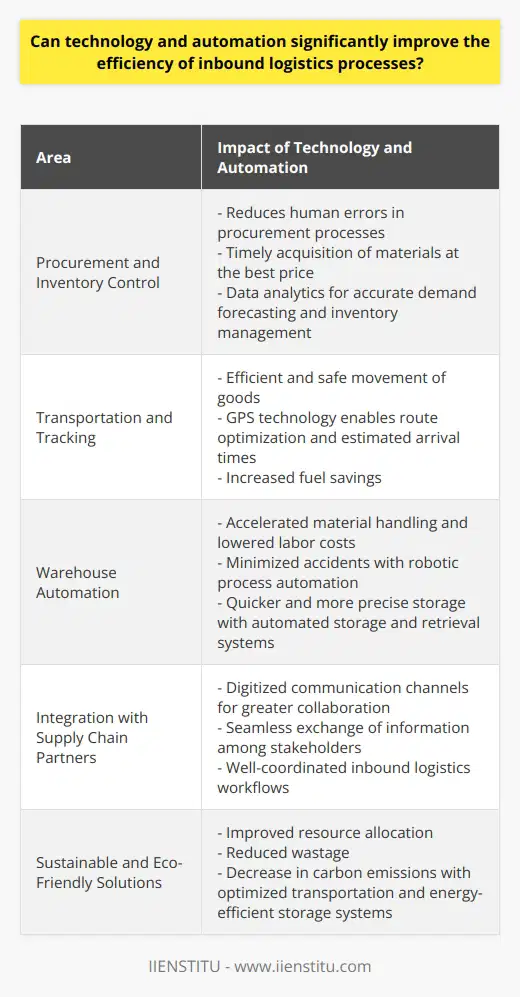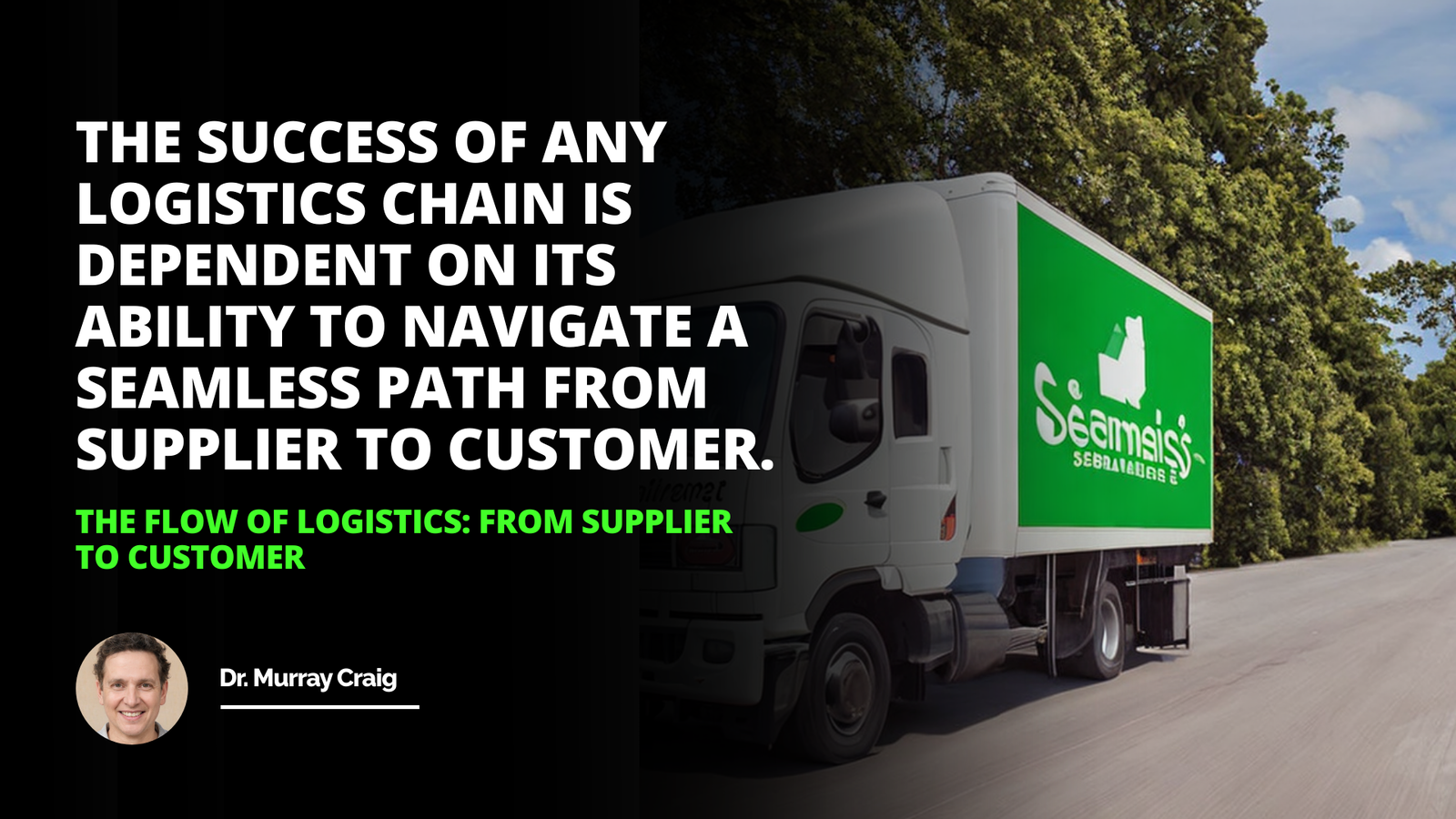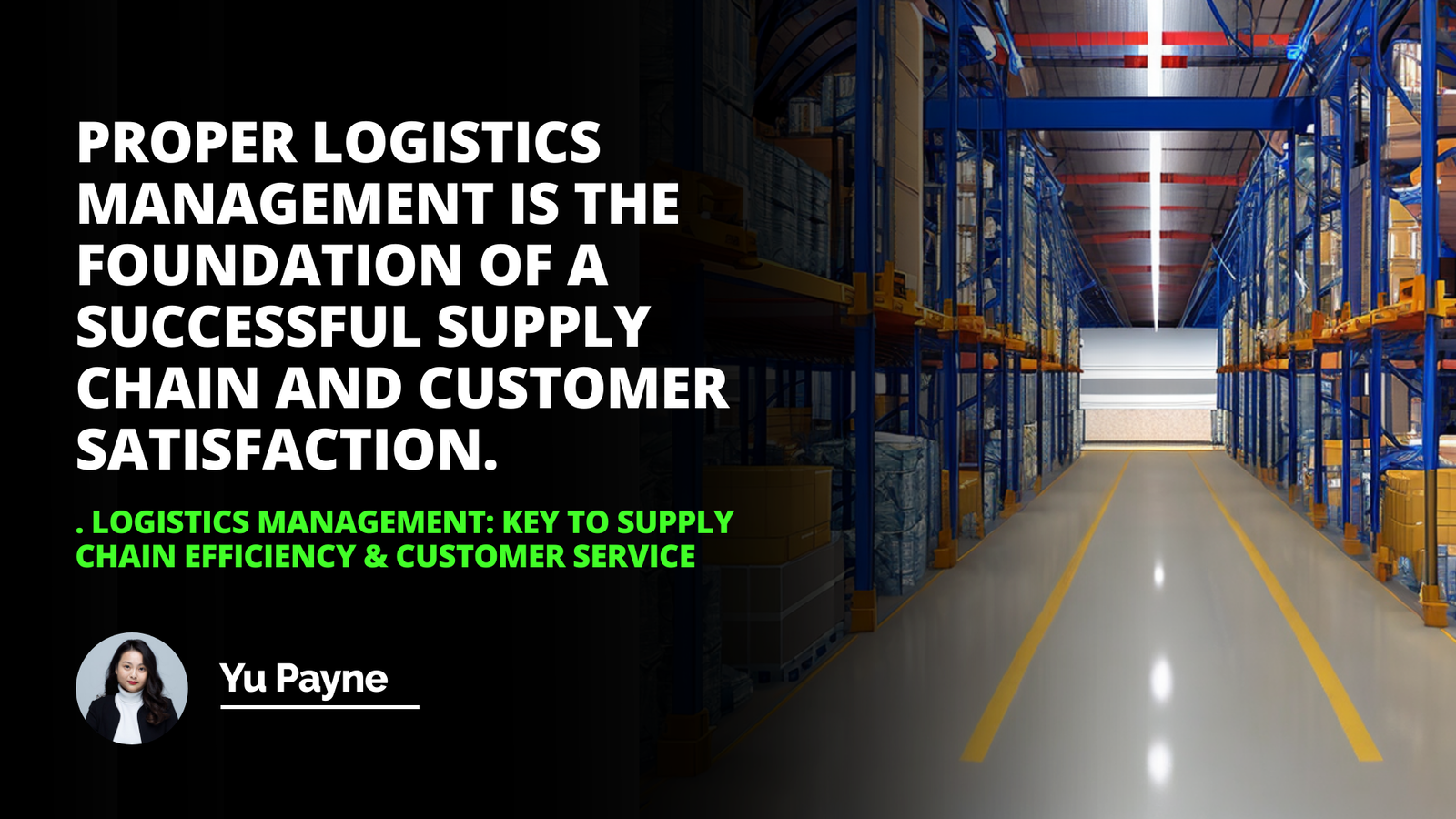
As I sat sipping my morning coffee in the bustling warehouse, watching the forklifts dart back and forth like worker bees, it dawned on me just how vital inbound logistics are to the lifeblood of any business. Years ago, when I first dipped my toes into the world of supply chain management, I naively thought that the magic happened only on the production floor or at the sales desk. Little did I know that the real game-changer was happening behind the scenes, where materials, resources, and information seamlessly flowed from suppliers to our company. Over time, after weathering a few storms and learning from my mistakes, I realized that inbound logistics isn't just about moving goods—it's about creating a well-oiled machine that keeps the entire operation running smoothly.
Benefits of Inbound Logistics
Challenges Faced in Implementing Inbound Logistics
Strategies for Optimizing Inbound Logistics
Impact of Inbound Logistics on Supply Chain Management
Understanding Inbound Logistics: The Heartbeat of Supply Chain Management
At its core, inbound logistics involves the activities of receiving, storing, and distributing materials from suppliers, vendors, and other sources. It's about getting the right products, in the right quantity, to the right place, at the right time. Think of it as the circulatory system of a business—without efficient inbound logistics, the rest of the body can't function properly.
The Essence of Inbound Logistics
Inbound logistics is more than just trucks and warehouses. It encompasses:
Transportation: Coordinating various modes of transport to bring materials in efficiently.
Storage: Managing warehouse space to store materials safely and accessibly.
Inventory Management: Keeping track of what comes in and goes out to maintain optimal stock levels.
Information Flow: Ensuring accurate and timely communication between suppliers and the company.
I remember when we first implemented an automated inventory system; it was like flipping a switch. Suddenly, we had real-time data on our stock levels, and could make more informed decisions.
The Importance of Inbound Logistics in Today's Business Landscape
With the rise of e-commerce and globalization, inbound logistics has taken center stage. Customers expect faster delivery times and greater product availability than ever before. Efficient inbound logistics management strategies are no longer a luxury—they're a necessity.
Benefits of Effective Inbound Logistics
The advantages of optimizing your inbound logistics are manifold:
1- Cost Reduction: By ordering materials only when needed, companies can reduce inventory holding costs.
2- Improved Customer Satisfaction: Timely procurement leads to timely production, which means customers get their products when they expect them.
3- Competitive Edge: Businesses that streamline their inbound logistics can respond more quickly to market changes.
4- Better Supplier Relationships: Efficient logistics can strengthen partnerships with suppliers, leading to more favorable terms.
5- Enhanced Flexibility: Companies can adapt more readily to fluctuations in demand.
Once, during a peak season rush, our optimized inbound logistics allowed us to meet increased demand without breaking a sweat, while competitors were scrambling to keep up.
Challenges in Implementing Inbound Logistics
Of course, optimizing inbound logistics processes isn't without its hurdles. Over the years, I've encountered several challenges that can throw a wrench in even the best-laid plans.
Coordination Complexities
Coordinating different transportation modes—air, sea, rail, and road—is akin to conducting an orchestra. If one section is off-beat, the whole performance suffers. Delays in shipping schedules, port congestions, and customs clearance issues can all cause disruptions.
Storage Limitations
Warehousing isn't just about stacking boxes. It's about efficiently using space to ensure materials are accessible when needed. Overstocking can lead to higher costs and increased risk of damage or obsolescence.
Information Overload
Tracking and monitoring the flow of materials require sophisticated systems. Without proper data management, it's easy to lose sight of inventory levels, leading to either shortages or surpluses.
The best way to maximize the benefits of inbound logistics is to anticipate and plan for the challenges.
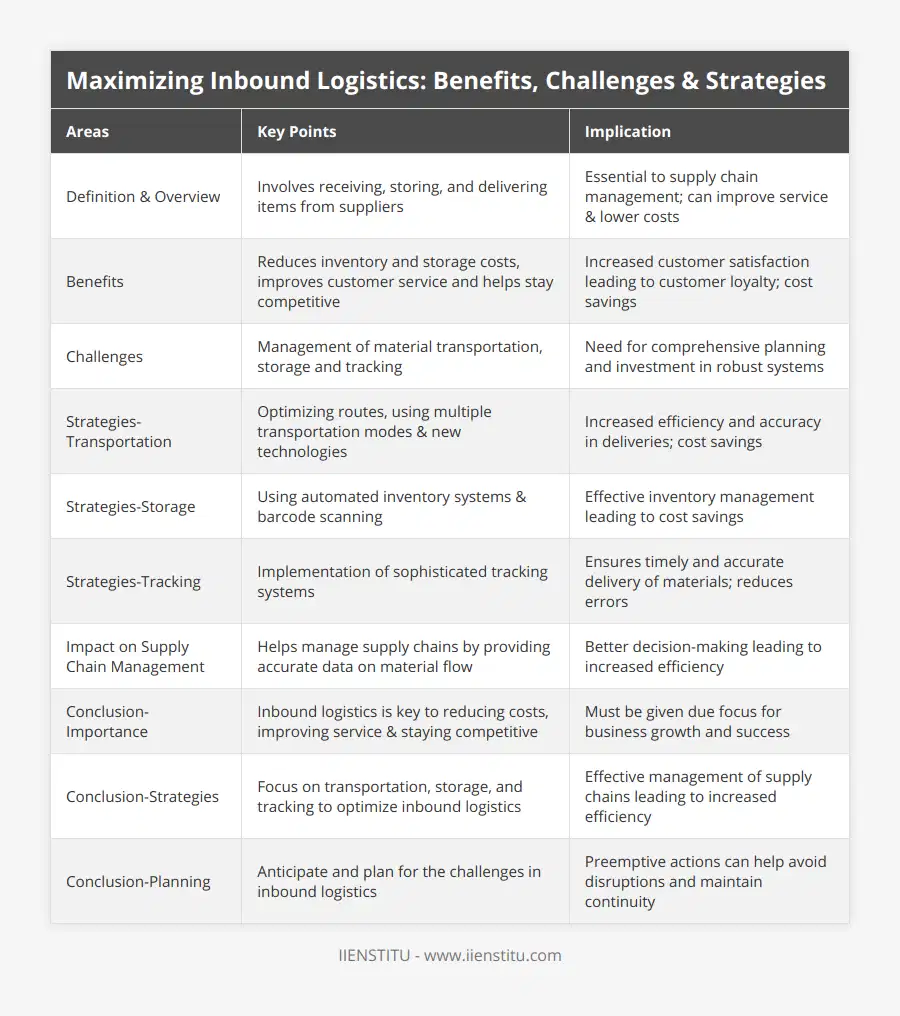
Human Factors
Let's face it—people make mistakes. Miscommunication, errors in documentation, or lack of training can result in significant inefficiencies. I recall an incident where a simple typo in an order form led to the delivery of 1,000 units instead of 100. It was a costly lesson in attention to detail.
Strategies for Optimizing Inbound Logistics
So, how do we overcome these challenges? Here are some strategies I've found effective over the years.
Embrace Technology
Automated Systems: Implementing automated inventory management systems can provide real-time visibility. This reduces human error and speeds up processes.
Barcoding and RFID: Using barcode scanning and Radio Frequency Identification (RFID) tags helps track materials accurately.
Advanced Tracking Systems: GPS and IoT devices allow for precise tracking of shipments.
Foster Strong Supplier Relationships
Building strong relationships with suppliers can lead to:
Better Communication: Clear, open lines of communication reduce misunderstandings.
Collaborative Planning: Working together on forecasts and demand planning can align expectations.
Improved Terms: Trust can lead to more favorable pricing or payment terms.
Optimize Transportation
Route Planning: Using software to plan the most efficient routes saves time and fuel.
Multiple Transportation Modes: Combining modes (e.g., sea and rail) can be more cost-effective.
Carrier Partnerships: Partnering with reliable carriers ensures better service levels.
Invest in Training
Your team is your greatest asset. Investing in their development pays dividends.
Regular Training Sessions: Keep staff updated on the latest technologies and processes.
Cross-Functional Training: Employees understand how their role fits into the bigger picture.
Empowerment: Encourage staff to suggest improvements. Often, those on the front lines have valuable insights.
Implement Lean Principles
Just-In-Time (JIT) Inventory: Order materials to arrive exactly when needed, reducing holding costs.
Continuous Improvement: Regularly assess and refine processes to eliminate waste.
Standardization: Standard procedures reduce variability and errors.
The Human Touch: Stories from the Field
Allow me to share a couple of experiences that highlight the importance of these strategies.
The Barcode Revelation
When we first introduced barcode scanning in our warehouse, there was resistance. Some team members preferred the old paper-based methods. However, after a few months, the benefits became clear. Inventory accuracy improved by 30%, and picking errors dropped significantly. One long-time employee admitted, "I didn't think we needed this technology, but now I can't imagine working without it."
Supplier Collaboration Pays Off
In another instance, we faced repeated delays from a key supplier. Instead of switching suppliers—a process that could have caused more disruption—we decided to work closely with them to identify the root causes. By sharing our forecasts and involving them in our planning process, we managed to reduce delivery lead times by 25%. It was a classic win-win situation.
The Impact of Inbound Logistics on Supply Chain Management
Efficient inbound logistics is a cornerstone of effective supply chain management. It can significantly impact:
Production Schedules: Reliable inbound logistics ensure that production lines aren't halted due to material shortages.
Financial Performance: Reduced inventory levels free up capital and reduce storage costs.
Customer Service: Meeting production schedules leads to on-time deliveries to customers.
Risk Management: Diversified sourcing and flexible logistics reduce vulnerability to disruptions.
As the saying goes, "A chain is only as strong as its weakest link." Inbound logistics is often that critical link that determines the strength of the entire supply chain.
Integrating Reassignment Strategies
Sometimes, optimizing inbound logistics may require reassigning resources or roles within the organization. If you find yourself in a position where you need to propose changes, it's crucial to communicate effectively. This is where understanding reassignment request letter tips and information can be invaluable. Crafting a clear and persuasive reassignment request can help gain buy-in from management and smooth the transition.
Looking to the Future: Trends in Inbound Logistics
The logistics landscape is ever-evolving. Here are some trends to watch:
Technological Advancements
Artificial Intelligence (AI): AI can optimize routing, predict demand, and manage inventory.
Blockchain: Offers secure and transparent tracking of goods.
Drones and Autonomous Vehicles: Potential to revolutionize last-mile delivery.
Sustainability
Green Logistics: Pressure to reduce carbon footprints is leading to more environmentally friendly practices.
Eco-Friendly Packaging: Reducing waste and using recyclable materials.
Globalization and Localization
Global Sourcing: While globalization offers cost benefits, it also introduces complexity.
Nearshoring: Some companies are moving production closer to home to reduce lead times.
Tips for Successfully Managing Inbound Logistics
To wrap things up, here are some practical tips I've gathered over the years:
1- Leverage Data Analytics: Use data to drive decision-making. Analyze trends and adjust accordingly.
2- Regularly Review Processes: What worked yesterday may not work today. Keep processes up-to-date.
3- Engage with Industry Peers: Join forums or associations to stay informed about best practices.
4- Monitor Supplier Performance: Keep tabs on supplier reliability and address issues promptly.
5- Stay Agile: Be prepared to adapt to changes in the market or supply chain disruptions.
My Personal Journey: Learning and Growing
Reflecting on my journey, I've come to appreciate the nuances of inbound logistics. It's been a path filled with trial and error, but each challenge has been a learning opportunity. There was a time when a delayed shipment caused a production halt, and I felt personally responsible. It was a hard lesson, but it taught me the importance of contingency planning and proactive communication.
I've also learned the value of collaboration. By working closely with suppliers, carriers, and internal teams, we've built a more resilient and efficient logistics network.
Conclusion: Embracing the Complexity
Inbound logistics may seem daunting with its myriad challenges, but it's also an area ripe with opportunities for improvement. By focusing on key strategies—embracing technology, fostering strong relationships, optimizing transportation, and investing in your team—you can transform inbound logistics from a potential bottleneck into a competitive advantage.
Remember, the best way to maximize the benefits of inbound logistics is to anticipate and plan for the challenges. Stay proactive, remain adaptable, and don't be afraid to innovate. After all, in the ever-changing world of business, it's those who embrace change who thrive.
In the words of logistics expert Donald J. Bowersox, "Supply chains are not a cost to be managed—they are an opportunity to deliver value to customers and shareholders."
References
1- Bowersox, D. J., Closs, D. J., & Cooper, M. B. (2013). Supply Chain Logistics Management. McGraw-Hill.
2- Rushton, A., Croucher, P., & Baker, P. (2017). The Handbook of Logistics and Distribution Management. Kogan Page Publishers.
3- Chopra, S., & Meindl, P. (2016). Supply Chain Management: Strategy, Planning, and Operation. Pearson.
4- Simchi-Levi, D., Kaminsky, P., & Simchi-Levi, E. (2009). Designing and Managing the Supply Chain: Concepts, Strategies and Case Studies. McGraw-Hill.
5- Christopher, M. (2016). Logistics & Supply Chain Management. Pearson.
Note: The above content is based on personal experiences and widely recognized industry practices. For further reading and in-depth understanding, please refer to the listed references.
Frequently Asked Questions
What are the benefits of maximizing inbound logistics?
Inbound logistics has become an increasingly important part of supply chain management. Maximizing inbound logistics can bring various benefits to a business, including improved customer service, lower inventory costs, and increased efficiency.
The most apparent benefit of maximizing inbound logistics is improved customer service. By reducing the time it takes to receive goods from suppliers, businesses can ensure they have the necessary items when customers need them. This helps to improve customer satisfaction and loyalty, which can lead to increased sales and profits for the business.
Another benefit of maximizing inbound logistics is lower inventory costs. By having items arrive sooner from suppliers, businesses can keep less inventory on hand to meet customer demand. This also allows companies to reduce their storage space requirements, leading to savings on rent and other related expenses. Additionally, by reducing the inventory that must be tracked and managed, businesses can save money by eliminating unnecessary labor costs associated with manual management processes.
Finally, maximizing inbound logistics can increase efficiency within a business's supply chain operations. By reducing load times between suppliers and customers, companies can better manage their resources and reduce waste throughout their supply chain processes. Additionally, by using technology such as EDI (Electronic Data Interchange) systems or automated ordering systems, businesses can streamline their ordering processes, leading directly to cost savings for the company and improving overall performance throughout their supply chain operations.
In conclusion, various benefits of maximizing inbound logistics should be considered when assessing a business's overall supply chain management strategy. Improved customer service through faster delivery times can lead directly to increased sales and profits for a company. At the same time, lower inventory costs help reduce expenses associated with storage space requirements and labor costs associated with tracking inventory levels manually. Finally, efficient use of resources throughout the supply chain process leads to cost savings for the business and improved overall performance throughout its supply chain operations.

What challenges can arise when implementing inbound logistics strategies?
Inbound logistics strategies are essential for efficient and cost-effective supply chain management. These strategies involve the planning and implementation of activities related to the flow of goods from the point of origin to the end of consumption. However, despite their importance, inbound logistics strategies can present several challenges.
One challenge associated with inbound logistics strategies is the complexity of managing multiple stakeholders. This includes suppliers, carriers, and 3PLs (third-party logistics providers). Each stakeholder has unique needs and requirements, and managing the relationships between them can be challenging. Additionally, the coordination of multiple stakeholders often involves high costs and resources.
Another challenge is the need for more visibility into the supply chain. Inbound logistics strategies rely heavily on data analysis and advanced analytics to identify trends, detect potential problems, and adjust the supply chain. As a result, it cannot be easy to manage inbound logistics processes without accurate and timely data.
Finally, inbound logistics strategies can be sensitive to external factors such as weather conditions, regulations, and market fluctuations. These external factors can significantly impact the supply chain, requiring frequent adjustments to the logistics plan.
In conclusion, inbound logistics strategies can present several challenges. These include the complexity of managing multiple stakeholders, the need for more visibility into the supply chain, and sensitivity to external factors. Therefore, to successfully implement inbound logistics strategies, organizations must be able to effectively manage these challenges.
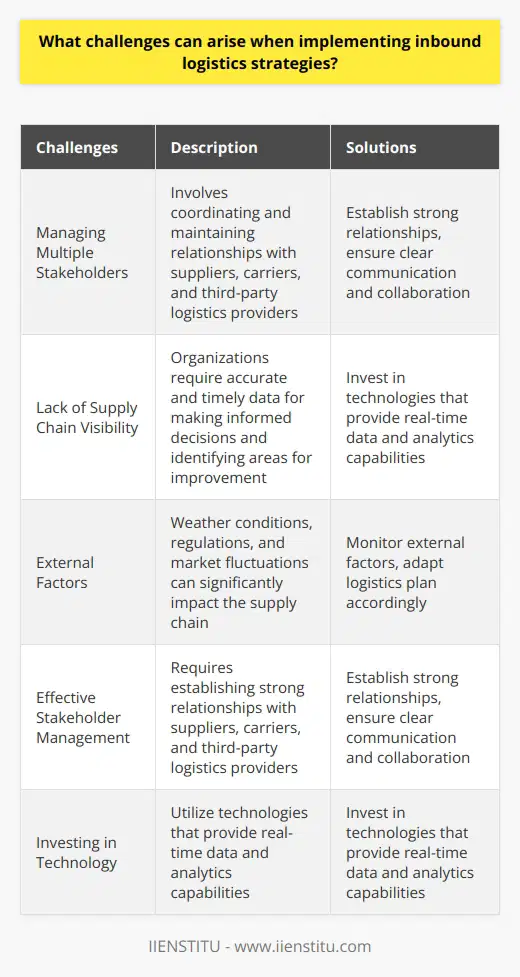
How can businesses maximize their inbound logistics to create a competitive advantage?
Inbound logistics is a critical element of the supply chain. Therefore, businesses need to optimize their operations to gain a competitive advantage. Inbound logistics involves efficiently moving goods and materials from suppliers to customers, which can be achieved through effective planning, coordination, and management. This article will discuss how businesses maximize their inbound logistics to create a competitive advantage.
First, businesses must develop an effective supply chain strategy tailored to their needs and goals. This strategy should include an analysis of the current supply chain network, identifying potential areas for improvement and cost savings, and developing methods for implementing these improvements. Additionally, businesses should introduce new technologies to streamline inventory management and order fulfillment processes.
Second, businesses must ensure that they have good relationships with their suppliers. This includes negotiating better terms on price and delivery times and developing long-term relationships with reliable suppliers who can provide quality goods at competitive prices. Additionally, businesses should consider using third-party logistics providers who can offer additional services such as transportation or warehousing solutions.
Thirdly, businesses should optimize inventory management systems by ensuring accurate data collection, timely replenishment cycles, and sufficient safety stock levels. This will enable them to reduce costs associated with storage space requirements and minimize losses due to expired or damaged products. Additionally, having accurate inventory data will allow businesses to make better purchasing decisions and customer service initiatives such as back-ordering options or customized delivery solutions.
Finally, businesses should improve their customer service initiatives to increase customer satisfaction and gain a competitive advantage over competitors who may not offer similar services or solutions. This could include offering faster delivery times or more customized solutions, such as tracking services where customers can view the progress of their orders online or via mobile applications. Additionally, providing superior customer service could increase sales due to positive word-of-mouth recommendations from satisfied customers, which can benefit any business's bottom line over time.
In conclusion, there are numerous ways a business can maximize its inbound logistics operations to gain a competitive advantage over its competitors while also reducing costs associated with inventory management systems or customer service initiatives such as backorder options or customized delivery solutions. By focusing on developing an effective supply chain strategy that takes into account factors such as improving supplier relations or introducing new technologies; optimizing inventory management systems; and enhancing customer service initiatives; any business can ensure that its inbound logistics operations are optimized so that it gains a significant edge over its competitors in terms of cost savings and customer satisfaction levels
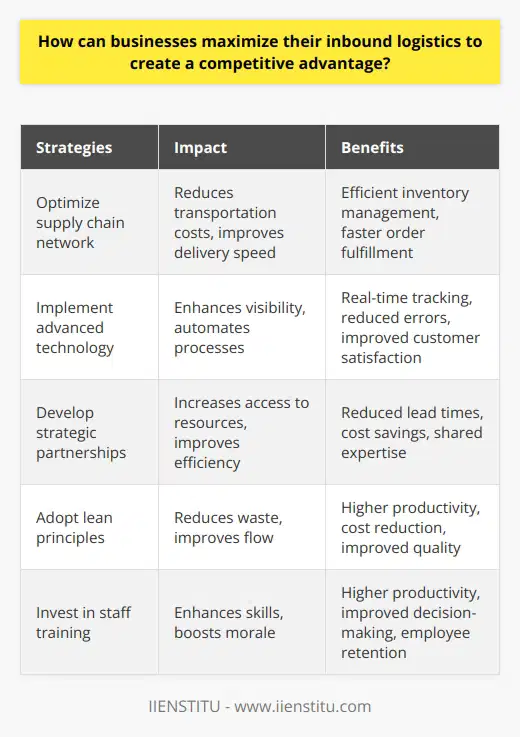
How do you optimize inbound logistics to achieve efficiency and cost reduction?
Analyzing Current Logistics Process
To optimize inbound logistics, it is crucial to first analyze the current logistics process. This involves examining factors such as transportation modes, inventory management, and collaboration with suppliers. By identifying gaps and areas for improvement, appropriate measures can be taken to achieve efficiency and cost reduction.
Selecting Appropriate Transportation Modes
The choice of transportation mode plays a vital role in inbound logistics optimization. Companies should assess various transportation modes and select the one that balances cost and delivery time. The chosen mode should ensure timely deliveries, minimize disruptions, and provide efficiency in the overall supply chain operations.
Establishing Effective Inventory Management Techniques
Efficient inventory management is essential for optimizing inbound logistics. Techniques like just-in-time (JIT) and demand-driven manufacturing can be employed to reduce inventory levels and carrying costs. Moreover, advanced technologies, such as warehouse management systems and RFID, can enhance visibility and control over inbound logistics processes.
Collaborating with Suppliers
Collaboration with suppliers is key in optimizing inbound logistics. Building strong partnerships and fostering communication can ensure a better understanding of each party's expectations, leading to improved planning and smoother operations. This collaboration can be facilitated by sharing information on forecasting, sales, and production using technology tools such as electronic data interchange (EDI) and enterprise resource planning (ERP) systems.
Implementing Lean Logistics Principles
Applying lean principles to inbound logistics operations can lead to significant cost reduction and efficiency improvements. Lean logistics involves eliminating waste, streamlining processes, and maximizing value for customers. Companies that adopt these practices can better manage their processes, reduce lead times, and minimize operational costs.
Monitoring and Evaluating Performance
To ensure that the optimization efforts are effective, it is essential to monitor and evaluate the performance of inbound logistics operations regularly. Key performance indicators (KPIs), such as delivery lead times, transportation costs, and order accuracy rates, should be analyzed to identify trends and areas for further improvement.
In conclusion, by analyzing the current process, selecting appropriate transportation modes, establishing effective inventory management techniques, collaborating with suppliers, implementing lean logistics principles, and continuously monitoring and evaluating performance, companies can successfully optimize their inbound logistics to achieve efficiency and cost reduction.
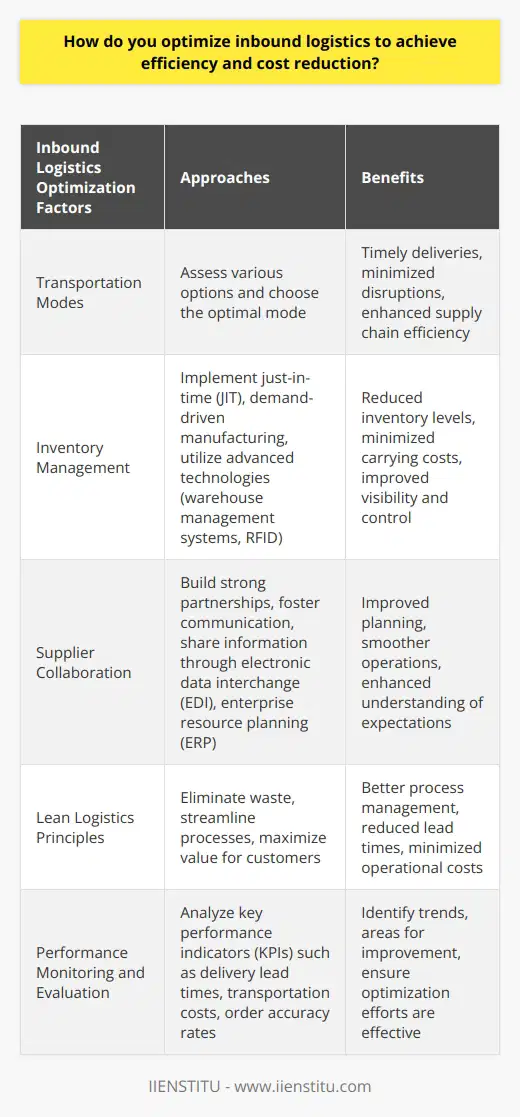
What is the primary purpose of developing an effective inbound logistics strategy?
Understanding the Primary Purpose
The primary purpose of developing an effective inbound logistics strategy is to streamline the flow of raw materials, components, and goods from suppliers to the organization. This ensures efficient utilization of resources and timely production, eventually leading to enhanced customer satisfaction and cost optimization.
Ensuring Timely Production
To achieve timely production, a well-planned inbound logistics strategy must be in place, monitoring and coordinating the procurement and transportation of materials. Proper scheduling, accurate forecasting, and efficient communication with suppliers are essential components in this process. By implementing a strong strategy, organizations can avoid delays in production and gain a competitive advantage.
Optimization of Storage and Inventory Costs
Inbound logistics management also involves optimizing storage and inventory costs. Organizations should maintain an ideal balance between understocking and overstocking by implementing reliable inventory management systems. This helps in reducing inventory holding costs and waste while maintaining the necessary stock levels for smooth production.
Minimizing Transportation Costs
Another key aspect of inbound logistics strategy is the optimization of transportation costs. Choosing the most effective and efficient transportation mode, consolidating shipments, and establishing strong relationships with carriers ensure cost savings in transportation. Additionally, using technology, such as real-time tracking systems, can further improve transportation efficiency and reduce costs.
Improving Supplier Relationships
Developing effective inbound logistics requires strong supplier relationships. Organizations can build these relationships by establishing clear communication channels, providing timely and accurate feedback, and offering honest assessments of supplier performance. These steps lead to better negotiation of contracts, improved quality of materials sourced, and reduced lead times.
Enhancing Customer Satisfaction
Ultimately, an effective inbound logistics strategy positively impacts customer satisfaction. By ensuring the timely production and delivery of goods, organizations can meet or even exceed customers’ expectations. Efficient logistics also contribute to better product quality assurance, reducing the likelihood of customer dissatisfaction and enhancing brand reputation.
In conclusion, the primary purpose of developing an effective inbound logistics strategy is to enhance operational efficiency, cost optimization, and customer satisfaction. A well-executed strategy ensures the timely flow of materials, optimized storage and transportation costs, strong supplier relationships, and improved customer satisfaction levels, ultimately contributing to overall organizational success.

What are the long-term benefits of implementing a successful logistics strategy for a company?
Improved Customer Satisfaction
A successful logistics strategy ensures the timely and efficient delivery of goods and services to customers. In the long term, this results in increased customer satisfaction due to greater reliability and predictability in meeting their demands. Satisfied customers are more likely to become repeat clients and recommend the company to other potential customers, thus increasing the overall market share and profitability of the company.
Cost Reduction
Implementing a well-planned logistics strategy can lead to substantial cost savings for a company. By streamlining supply chain processes and optimizing inventory management, firms can reduce waste, minimize storage expenses, and decrease the need for costly expedited shipments. These savings accumulate over time and contribute to greater profitability and financial stability, freeing up resources to invest in other areas of the business, such as research and development or marketing initiatives.
Increased Competitiveness
A successful logistics strategy can give a company a competitive edge in the market. Efficient supply chain management and logistics operations allow for swifter response times to shifting market conditions or consumer preferences, enabling businesses to adapt and prosper in a rapidly changing landscape. Furthermore, superior logistics performance can establish a company as a preferred supplier or partner, enhancing its reputation in the industry and fostering stronger business relationships.
Enhanced Risk Management
A robust logistics strategy also involves the implementation of risk management measures, such as contingency planning and the use of reliable carriers and suppliers. This proactive approach helps companies better prepare for unforeseen challenges and disruptions in the supply chain, allowing for swift recovery and ensuring minimal impact on overall operations. Long-term benefits of such risk management include increased resilience and agility, positioning the company for continued success in the face of potential obstacles.
Sustainability and Corporate Social Responsibility
Finally, a comprehensive logistics strategy often incorporates sustainable practices and adherence to ethical standards. Efforts to reduce carbon emissions, waste, and excessive energy consumption in logistics operations are not only beneficial for the environment but also contribute to the company's overall corporate social responsibility (CSR) profile. A strong commitment to CSR can enhance a company's reputation and appeal to environmentally conscious consumers, while also reducing potential regulatory risks as environmental regulations become increasingly stringent.
In conclusion, effective logistics strategies yield numerous long-term benefits for businesses, improving customer satisfaction, reducing costs, increasing competitiveness, enhancing risk management, and promoting sustainability. By investing in the development and implementation of a solid logistics strategy, companies can ensure their stability and success in a continually evolving global marketplace.
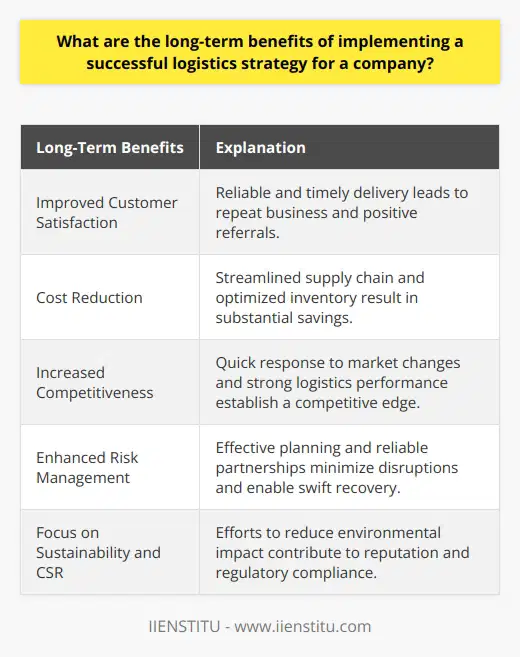
What are the key factors to consider when developing an inbound logistics strategy?
Inbound Logistics Strategy: Key Factors
**Supplier Relationships**
Developing strong supplier relationships is crucial in an inbound logistics strategy. By maintaining open and transparent communication, organizations can collaborate with suppliers to ensure the timely delivery of high-quality products and materials.
**Transportation Management**
Effective transportation management is another key factor in a successful inbound logistics strategy. Companies must consider various modes of transportation, such as road, rail, air, and sea, and select the most efficient, cost-effective, and environmentally friendly option for their specific needs.
**Inventory Management**
Proper inventory management is essential for an optimal inbound logistics strategy. Businesses must accurately forecast customer demand, establish optimal inventory levels, and reduce excess stock to avoid costly storage fees and obsolescence.
**Quality Control**
Implementing quality control measures throughout the inbound logistics process can enhance the overall efficiency of a supply chain. By closely monitoring the quality of incoming shipments, companies can reduce the occurrence of defects, returns, and wasted time on dealing with problematic items.
**Supply Chain Visibility**
Ensuring visibility throughout the entire supply chain can significantly improve an inbound logistics strategy. This transparency enables organizations to track and trace their products and materials, stay informed of potential disruptions, and respond quickly to any issues that may arise.
**Technology Integration**
Leveraging technology, such as warehouse management systems (WMS), transportation management systems (TMS), and integration with other enterprise systems (e.g., ERP), can streamline the inbound logistics process. These solutions can provide real-time data, automate manual tasks, and improve overall efficiency and accuracy.
**Risk Management**
To develop a robust inbound logistics strategy, companies must consider various risks and contingencies related to their supply chain. By identifying potential threats, organizations can implement mitigation strategies and develop backup plans to keep their supply chain running smoothly.
In conclusion, when developing an inbound logistics strategy, it is vital to consider various factors such as supplier relationships, transportation management, inventory management, quality control, supply chain visibility, technology integration, and risk management. By addressing these key elements, organizations can create an effective and efficient inbound logistics process that positively impacts their overall business operations.
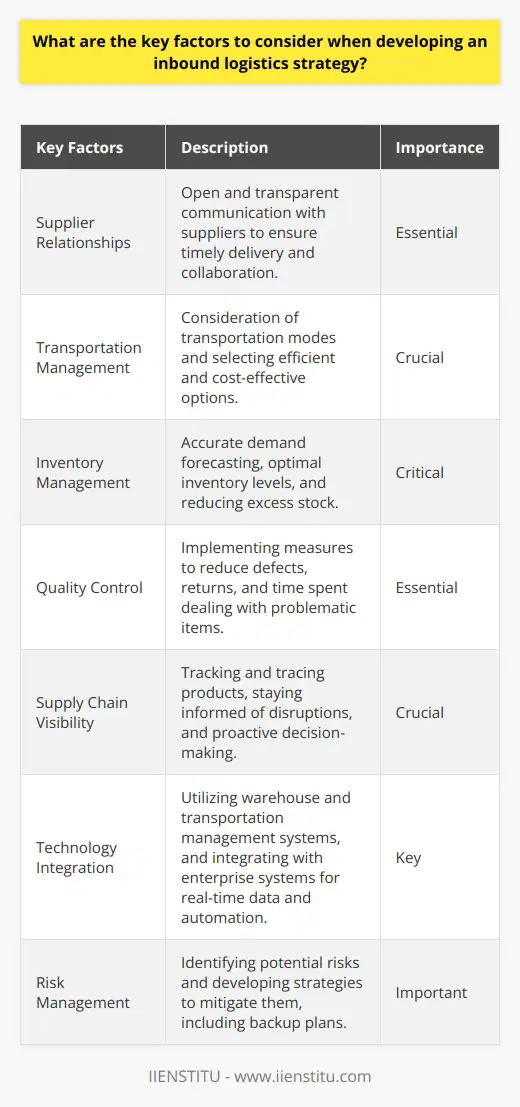
How do inbound logistics challenges differ across various industries?
Inbound Logistics Challenges in Various Industries
Distinctive Features
Inbound logistics challenges often differ across industries due to their distinct nature, operational requirements, and regulatory environment. For instance, the automotive, pharmaceutical, and textile industries each face unique obstacles in efficiently managing the flow of materials and resources required for production.
Automotive Industry
In the automotive industry, challenges stem from the high volume of parts, components, and raw materials used in manufacturing. Companies must manage the timely delivery of these items while adhering to strict quality standards. As a result, these firms face intricate supplier networks, complicated inventory management practices, and the risk of supply chain disruptions due to increasing global competition.
Pharmaceutical Industry
The pharmaceutical industry grapples with complex regulatory requirements for securing the safe, consistent supply of raw materials and active pharmaceutical ingredients needed for drug development. Companies must address challenges in managing the cold chain, maintaining pharmaceutical quality, counterfeiting, and compliance with the drug regulatory authorities' ordinances. Additionally, the COVID-19 pandemic showcased the vulnerability of pharmaceutical supply chains, stressing the need for robust inbound logistics management techniques.
Textile Industry
Lastly, the textile industry faces substantial environmental and social concerns surrounding raw materials' procurement, such as water pollution, deforestation, and exploitation of workers. Companies must navigate a vast, global network of suppliers, ensuring sustainable practices and quality management while balancing cost and efficiency. Furthermore, the fast-paced nature of fashion trends places significant pressure on firms to accelerate production cycles and improve supply chain agility.
Cross-industry Challenges
Despite the industry-specific differences outlined above, there are common challenges in inbound logistics management faced by all industries. These include increasing environmental concerns necessitating greener logistics practices, increased reliance on digital technologies for improved visibility and collaboration, and the need for robust risk management strategies to mitigate the impact of unexpected disruptions. By understanding these unique challenges and investing in effective solutions, companies can better position themselves for long-term success in their respective market environments.
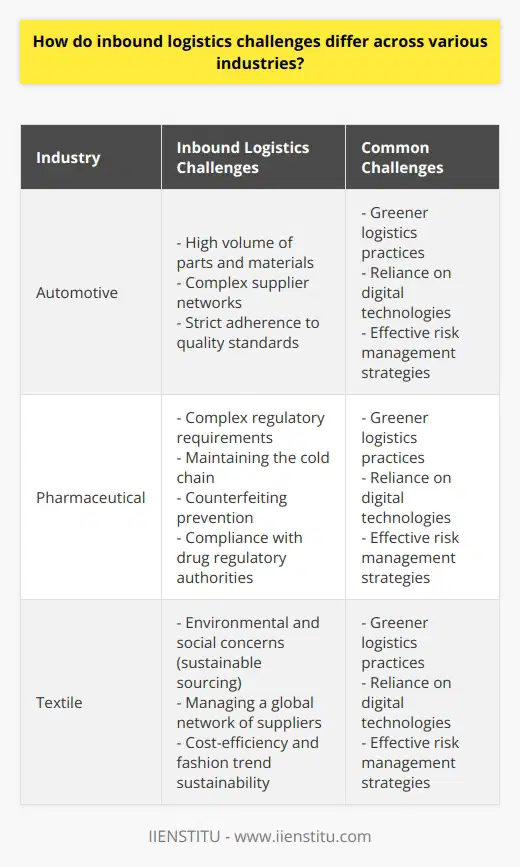
Can technology and automation significantly improve the efficiency of inbound logistics processes?
Impact on Inbound Logistics Efficiency
Undoubtedly, technology and automation can significantly improve the efficiency of inbound logistics processes. Inbound logistics, encompassing activities such as procurement, handling, transportation, and warehousing, is crucial for smooth functioning and cost optimization.
Procurement and Inventory Control
Automation of procurement processes can reduce human errors and ensure timely acquisition of materials at the best available price. Integrating data analytics can provide valuable insights, forecast demand accurately, and streamline inventory management.
Transportation and Tracking
Smart transportation systems, leveraging GPS technology and real-time monitoring, enable efficient and safe movement of goods. Improved positioning and tracking offer better route optimization, estimated arrival times and increased fuel savings.
Warehouse Automation
Robotic process automation (RPA) in warehouses significantly accelerates material handling, lowers labor costs and minimizes the scope for accidents. Automated storage and retrieval systems (AS/RS), for instance, allow quicker and precise storage of products, maximizing space utilization.
Integration with Supply Chain Partners
Digitization of communication channels and data sharing among supply chain stakeholders promotes greater collaboration and ensures well-coordinated inbound logistics workflows. Electronic Data Interchange (EDI), cloud-based systems and application programming interfaces (APIs) support seamless exchange of information among suppliers, transportation providers, and warehouses.
Sustainable and Eco-friendly Solutions
Smart logistics operations that embrace technologies such as AI, IoT, and blockchain result in improved resource allocation, reduced wastage, and sustainable operations. Environmental benefits include a decrease in carbon emissions due to optimized transportation and energy-efficient storage systems.
In conclusion, incorporating technology and automation within inbound logistics enhances efficiency and minimizes delays at various stages of the process. Adopting these advancements not only reduces overall operational costs but also fosters greener initiatives. As supply chains continue to evolve, the benefits of integrating technology into inbound logistics processes will only become more apparent and transformative.
